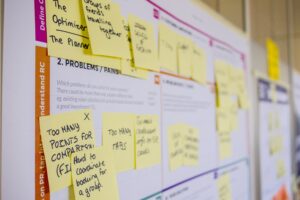Starting and scaling a business has always been a challenging journey, with no guarantee of success. However, the emergence of the Lean Startup Method has revolutionized this process by providing a systematic and iterative approach to product development and customer validation. This approach has transformed the startup landscape and sparked a new wave of innovation that is driving economic growth worldwide. In this article, we will explore the origins, key principles, and implementation of the Lean Startup Method, as well as its real-world examples and future prospects.
Understanding the Lean Startup Method
Origins of the Lean Startup Method
The Lean Startup Method was created by Eric Ries, who observed that many successful companies did not have a clear path to achieve their success, but instead they followed an iterative process of testing, learning, and adapting. This insight led him to develop a new methodology that was inspired by the principles of lean manufacturing and agile development. The Lean Startup Method proposes that startups should focus on creating a minimum viable product (MVP) that meets the needs of early adopters and gathers feedback from these customers to refine their product and business model.
Key Principles of the Lean Startup Method
The Lean Startup Method is built upon five key principles:
- Entrepreneurship is management: The startup is a management challenge that requires a disciplined approach to achieve success.
- Validated learning: The startup should focus on learning from customers’ feedback and data to refine their product and business model.
- Build-Measure-Learn feedback loop: The startup should create an iterative process that builds and tests the MVP, measures its impact on customers, and learns from the feedback to make informed decisions.
- Minimum viable product (MVP): The startup should create a version of the product that has just enough features to meet the needs of early adopters and gather feedback.
- Continuous innovation: The startup should embrace a culture of experimentation and innovation to adapt to changing market conditions and customer needs.
The Build-Measure-Learn Feedback Loop
The Build-Measure-Learn feedback loop is the heart of the Lean Startup Method and represents an iterative process of product development and customer validation. The loop starts by building a minimum viable product (MVP) that meets the basic needs of early adopters. Then, the startup measures the impact of the MVP on customers and gathers feedback from them. Finally, the startup learns from the feedback to refine its product and business model. This process is repeated until the startup achieves product-market fit and finds a sustainable business model.
Implementing the Lean Startup Method in Your Business
Defining Your Minimum Viable Product (MVP)
The first step in implementing the Lean Startup Method is to define your minimum viable product (MVP). The MVP is the simplest version of your product that meets the needs of your early adopters and allows you to gather feedback. The MVP should focus on the core features that provide the most value to customers, and it should be designed to test your assumptions about the market and customer needs. The MVP should also be built with a minimum investment of time and resources to maximize the speed of learning.
Validating Your Business Hypotheses
Once you have defined your MVP, the next step is to validate your business hypotheses. Your business hypotheses are the assumptions that you have made about your market, customers, and business model. The Lean Startup Method proposes that you should test these hypotheses by gathering feedback from customers and measuring their behavior. You should also use lean analytics to track the key metrics that indicate the success of your product and business model.
Pivoting and Iterating Based on Customer Feedback
Based on the feedback that you gather from customers, you may need to pivot or iterate your product and business model. Pivot means to change your approach significantly based on the feedback that you have received. Iteration means to make incremental improvements to your product and business model based on the feedback. The goal of pivoting and iteration is to find the right product-market fit and create a sustainable business model.
Real-World Examples of the Lean Startup Method in Action
Successful Companies That Used the Lean Startup Method
Many successful companies have used the Lean Startup Method to achieve their success, including Dropbox, Airbnb, and Buffer. Dropbox started as a simple MVP that allowed users to store and share files in the cloud. Dropbox’s MVP was so successful that it attracted millions of users and investors, and the company was able to pivot to become a leader in cloud storage and collaboration. Airbnb started as a simple website that allowed users to rent out their couches to travelers. Airbnb’s MVP was so successful that it attracted a large number of hosts and guests, and the company was able to pivot to become a leader in the travel industry. Buffer started as a simple MVP that allowed users to schedule social media posts. Buffer’s MVP was so successful that it attracted a large number of users and investors, and the company was able to iterate to create a suite of social media management tools.
Lessons Learned from Lean Startup Failures
Not all startups that use the Lean Startup Method succeed. One of the most important lessons learned from Lean Startup failures is the importance of focusing on the right metrics. Startups that fail often focus on vanity metrics, such as website traffic or social media followers, rather than actionable metrics, such as conversion rate or customer retention. Another lesson learned is the importance of avoiding premature scaling. Startups that scale too early often burn through their resources and fail to achieve product-market fit.
Comparing the Lean Startup Method to Traditional Entrepreneurship Approaches
The Waterfall Model vs. the Lean Startup Method
The Lean Startup Method is often compared to the waterfall model, which is a traditional approach to software development that emphasizes detailed planning and sequential execution. The waterfall model assumes that the requirements and design of the project are complete and accurate before development begins. The Lean Startup Method, on the other hand, assumes that the requirements and design of the project are uncertain and that the development process should focus on validating assumptions and gathering feedback from customers. The Lean Startup Method is therefore more agile and adaptive than the waterfall model.
Advantages and Disadvantages of Each Approach
The advantages of the Lean Startup Method over the waterfall model include faster speed to market, lower development costs, and greater customer satisfaction. The disadvantages of the Lean Startup Method include the risk of not meeting all customer needs, the risk of not achieving a sustainable business model, and the risk of not managing resources effectively. The advantages of the waterfall model over the Lean Startup Method include greater predictability, higher quality assurance, and better risk management. The disadvantages of the waterfall model include greater time to market, higher development costs, and lower customer satisfaction.
The Future of the Lean Startup Method
How the Lean Startup Method is Evolving
The Lean Startup Method is evolving to meet the changing needs of startups and businesses. One of the most important trends is the integration of Lean Startup principles with other methodologies, such as design thinking and agile development. Another trend is the adoption of Lean Startup principles by larger organizations, which are seeking to innovate and compete with startups. The Lean Startup Method is therefore becoming a mainstream approach to entrepreneurship and innovation.
The Role of the Lean Startup Method in the Age of Digital Transformation
The Lean Startup Method is playing a critical role in the age of digital transformation, where businesses must adapt quickly to changing market conditions and customer needs. The Lean Startup Method provides a framework for creating and testing innovative solutions that can help businesses stay ahead of the curve. The Lean Startup Method is therefore becoming an essential skill for entrepreneurs, innovators, and change agents who want to drive the future of business.
Conclusion
The Lean Startup Method has transformed the world of entrepreneurship and innovation by providing a systematic and iterative approach to product development and customer validation. The Lean Startup Method has enabled startups to create successful businesses by focusing on creating minimum viable products, gathering feedback from customers, and embracing a culture of continuous innovation. The Lean Startup Method is becoming an essential skill for entrepreneurs, innovators, and change agents who want to create successful businesses in the age of digital transformation.








